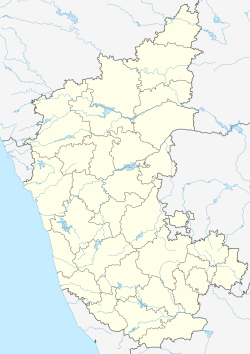
Haveri is a district in the state of Karnataka, India. As of 2011, it had a population of 1,597,668, out of which 20.78% were urban residents. The district headquarters is Haveri. Ranebennur is the biggest city in Haveri district with population and the commercial city and business headquarters and seeds production hub.
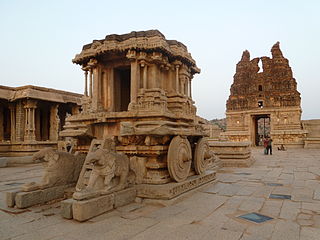
Koppala district, officially known as Koppala district is an administrative district in the state of Karnataka in India. In the past Koppal was referred to as 'Kopana Nagara'. Hampi, a World heritage center, covers some areas of Koppala District. It is situated approximately 38 km away. Anegundi, is also a famous travel destination.

Lakkundi, also referred to as Lokkugundi, was a major city before the 14th century, and is now a village in Gadag District of Karnataka, India. By 10th century, it was already a major economic and commerce center with mint operations for South India, one mentioned in Kannada and Sanskrit inscriptions and texts. By 12th century, many Hindu and Jain temples had been consecrated here, along with public infrastructure such as stepwells and water reservoirs. Among the major temples are the Brahma Jinalaya (oldest), Mallikarjuna, Lakshminarayana, Manikeshwara, Naganatha, Kumbheshvara, Nanneshwara, Someshwara, Narayana, Nilakanteshwara, Kasivisesvara, Virabhadhara, Virupaksha, and others. As its importance and wealth grew, Lakkundi became one of the capitals of the Hoysala Empire.

North Karnataka is a geographical region in Deccan plateau from 300 to 730 metres elevation that constitutes the region of the Karnataka state in India and the region consists of 14 districts. It is drained by the Krishna River and its tributaries the Bhima, Ghataprabha, Malaprabha, and Tungabhadra. North Karnataka lies within the Deccan thorn scrub forests ecoregion, which extends north into eastern Maharashtra.
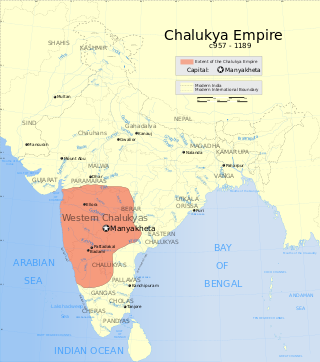
The Western Chalukya Empire ruled most of the western Deccan, South India, between the 10th and 12th centuries. This Kannada-speaking dynasty is sometimes called the Kalyani Chalukya after its regal capital at Kalyani, today's Basavakalyan in the modern Bidar district of Karnataka state, and alternatively the Later Chalukya from its theoretical relationship to the 6th-century Chalukya dynasty of Badami. The dynasty is called Western Chalukyas to differentiate from the contemporaneous Eastern Chalukyas of Vengi, a separate dynasty. Before the rise of these Chalukyas, the Rashtrakuta Empire of Manyakheta controlled most of the Deccan Plateau and Central India for over two centuries. In 973, seeing confusion in the Rashtrakuta empire after a successful invasion of their capital by the ruler of the Paramara dynasty of Malwa, Tailapa II, a feudatory of the Rashtrakuta dynasty ruling from Bijapur region defeated his overlords and made Manyakheta his capital. The dynasty quickly rose to power and grew into an empire under Someshvara I who moved the capital to Kalyani.

Annigeri is a taluk of Dharwad district in the state of Karnataka, India, located 20 km west of Gadag en route to Hubli and 35 km from Hubli.

Lakshmeshwara is a town, and newly created Taluk place along with Gajendragad in Gadag district, in the Indian state of Karnataka. It is about 40 km from Gadag and 55 km from Hubli. It is an agricultural trading town. Lakshmeshwara Temple dedicated to Shiva. There are many important temples in this historic town, including the other Shiva temple, the Someshwara Temple. There are two ancient Jain temples in the town, as well as a notable Jamma Masjid. Lakshmeshwara is also home for many smaller shrines, a dargah, the Kodiyellamma temple, the Mukha Basavanna shrine, and a gigantic idol of Suryanarayana.
Shiggaon, also known as Shiggavi is a municipal town in Haveri district in the Indian state of Karnataka.
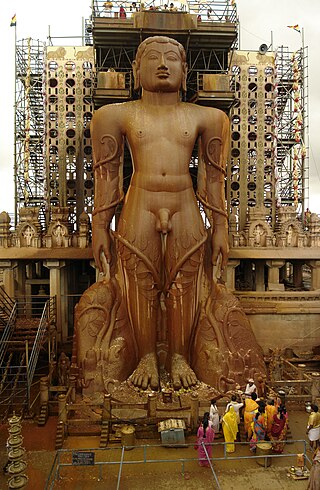
Karnataka, the sixth largest state in India, was ranked as the third most popular state in the country for tourism in 2014. It is home to 507 of the 3600 centrally protected monuments in India, second only to Uttar Pradesh. The State Directorate of Archaeology and Museums protects an additional 752 monuments and another 25,000 monuments are yet to receive protection.
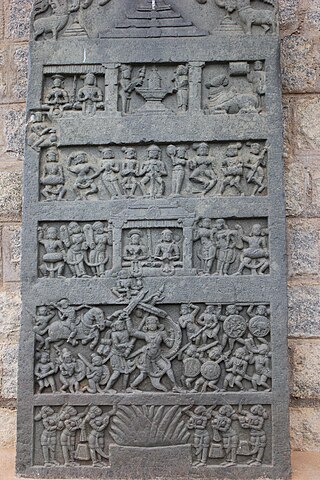
A hero stone is a memorial commemorating the honorable death of a hero in battle. Erected between the second half of the first millennium BCE and the 18th century CE, hero stones are found all over India. They often carry inscriptions and a variety of ornaments, including bas relief panels, frieze, and figures in carved stone. Usually they are in the form of a stone monument and may have an inscription at the bottom with a narrative of the battle. The earliest and oldest of such memorial hero stones is found in the Indian state of Tamil Nadu is more than 2400 years old that is 4th century BCE. According to the historian Upinder Singh, the largest concentration of such memorial stones is found in the Indian state of Karnataka. About two thousand six hundred and fifty hero stones, the earliest in Karnataka is dated to the 5th century CE. The custom of erecting memorial stones dates back to the Iron Age though a vast majority were erected between the 4th century BCE to 13th centuries CE.

The Siddhesvara Temple is located in Haveri in Haveri district, Karnataka state, India. It is considered an ornate example of 12th-century Western Chalukyan art and is well known for the many loose sculptures of Hindu deities that exist in it. However, inscriptional evidence would suggest that the initial consecration of the temple was in the late 11th century. An exciting aspect of the temple is that it faces west instead of facing the rising sun in the east–a standard in Chalukyan constructions. Though it is currently used as a Shaiva temple dedicated to God Shiva, historians are unsure by which faith or sect the temple was consecrated initially and to which deity. Many people visit the temple for their spiritual beliefs, while evidence about temple visits can be found in Gita chapter 17, verse 23, which says otherwise. Most of the Lord Shiva sculptures are observed to be of him meditating. There are claims that he meditates on himself, whereas some proof can be found in Devi-Bhagavata Purana that Lord Shiva meditates for some other God. This uncertainty perhaps stems from the many loose sculptures of deities and the degradation of primary wall images.
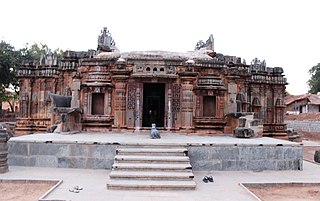
The Chandramauleshwara Temple, sometimes referred to as the Candramauḷĩśvara or Chandramouleshwara temple at Unkal, is an 11th century Shiva temple with Chalukyan architecture in Unkal (Hubballi), Karnataka, India. It is built on a square-cross plan with one entrance for each cardinal direction, corresponding to the sandhara plan found in Sanskrit texts on architecture. It originally had a Chaturmukha (four-faced) Linga in the center of the temple and many more mandapas (halls), but the surviving structure is much smaller.

Temples of North Karnataka

Kuknoor is a town in Kukanoor taluk in the Koppal District of the Indian state of Karnataka, which is located about 40 km northwest of Hospet and 7 km from the Mahadeva Temple in Itagi. Kuknoor is known for the temples of the Rashtrakutas and Chalukyas in the town, with the most notable being the Navalinga Temple.
Galaganath is a small village located near Haveri, in the Haveri District, Karnataka. Located here is the famous Galageshwar Shiva Temple built during the rule of the Western Chalukyas. This large temple faces east and is situated along the Tungabhadra River. The rivers Tunga and Varada join at Galaganath.
Rattihalli is a new taluk in the southern state of Karnataka, India. It is located in the Haveri district in Karnataka. It is around 26 km from Ranebennur and around 16 km from Hirekerur. The Veerabhadreshwara Car festival is very famous in Rattihalli.
Shri Kuruvathi Basaveshwara temple at Kuruvathi is one of the ancient and historic temples at the extreme south-western corner of Hoovina Hadagali taluk, Vijayanagara District, Karnataka, India. This temple is on the bank of Tungabhadra river, 10 km from Halavagalu and 2 km from Mylara and 36 km from Ranebennur and 326 km from Bangalore.

Kadamba architecture was a style of temple architecture founded by Mayurasharma in the 4th century AD in Karnataka, India. Kadambas created new style of architecture which was the basis of the Hoysalas style of architecture, developed original school of sculpture, was the forerunner of series of South Indian sculptors. Many temples at Aihole, Badami and Hampi are built in Kadamba style.
Aremallapur is a village in the southern state of Karnataka, India. It is located in the Ranebennur taluk of Haveri district in Karnataka.
